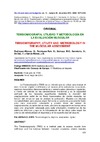Please use this identifier to cite or link to this item:
https://accedacris.ulpgc.es/jspui/handle/10553/45289
| Title: | Tensiomiografía, utilidad y metodología en la evaluación muscular | Other Titles: | Tensiomygraphy, utility and methodology in the muscular assessment | Authors: | Rodríguez-Matoso, Dario Rodríguez Ruiz, David Gustavo Quiroga Escudero, Miriam Esther Sarmiento Montesdeoca, Samuel Saá Guerra, Yves de García-Manso, Juan Manuel |
UNESCO Clasification: | 241106 Fisiología del ejercicio | Keywords: | Tensiomiografía Deporte Evaluación Rigidez Tensiomyography, et al |
Issue Date: | 2010 | Journal: | Revista Internacional de Medicina y Ciencias de la Actividad Fisica y del Deporte | Abstract: | La Tensiomiografía (TMG) es un método que se utiliza para evaluar el tono muscular (rigidez o stiffness) y el balance entre estructuras musculares, cadenas musculares (flexora-extensora) o extremidades (derecha e izquierda), a través del análisis de las características mecánicas y de la capacidad contráctil de los músculos superficiales mediante la medición del desplazamiento radial de las fibras transversales del vientre muscular, en función del tiempo en que se produce la contracción. Muestra una elevada reproducibilidad, pero precisa seguir fielmente un protocolo previamente fijado para cada evaluación: colocación y presión inicial del sensor de desplazamiento; duración del estímulo, así como la separación en tiempo entre cada uno; angulación adecuada para cada articulación; incrementos de los estímulos eléctricos y que en la interpretación de los datos debe seguir los criterios de individualidad del deportista y el de especificidad del deporte. The Tensiomyography (TMG) is a method used to assess muscle tone (stiffness) and the balance between muscular structures, chains muscles (flexor-extensor) and extremities (right and left), by analyzing the mechanical characteristics and contractile capacity of superficial muscles by measuring the radial displacement of the transversal fibers in the muscle belly, according to the time at which the contraction. Shows a high repeatibility, but we need to follow protocol previously established for each assessment: placement and initial pressure of the sensor displacement; duration of stimulation, and the separation between each one; angle for each joint; increases the electrical stimuli and the interpretation of data must follow the criteria of the individual athlete and the specificity of sport. |
URI: | https://accedacris.ulpgc.es/handle/10553/45289 | ISSN: | 1577-0354 | Source: | Revista Internacional de Medicina y Ciencias de la Actividad Fisica y del Deporte [ISSN 1577-0354], v. 10 (40), p. 620-629, (Diciembre 2010) |
| Appears in Collections: | Artículos |
SCOPUSTM
Citations
13
checked on Jun 8, 2025
WEB OF SCIENCETM
Citations
11
checked on Feb 25, 2024
Page view(s)
71
checked on Feb 24, 2024
Download(s)
34
checked on Feb 24, 2024
Google ScholarTM
Check
Share
Export metadata
Items in accedaCRIS are protected by copyright, with all rights reserved, unless otherwise indicated.
